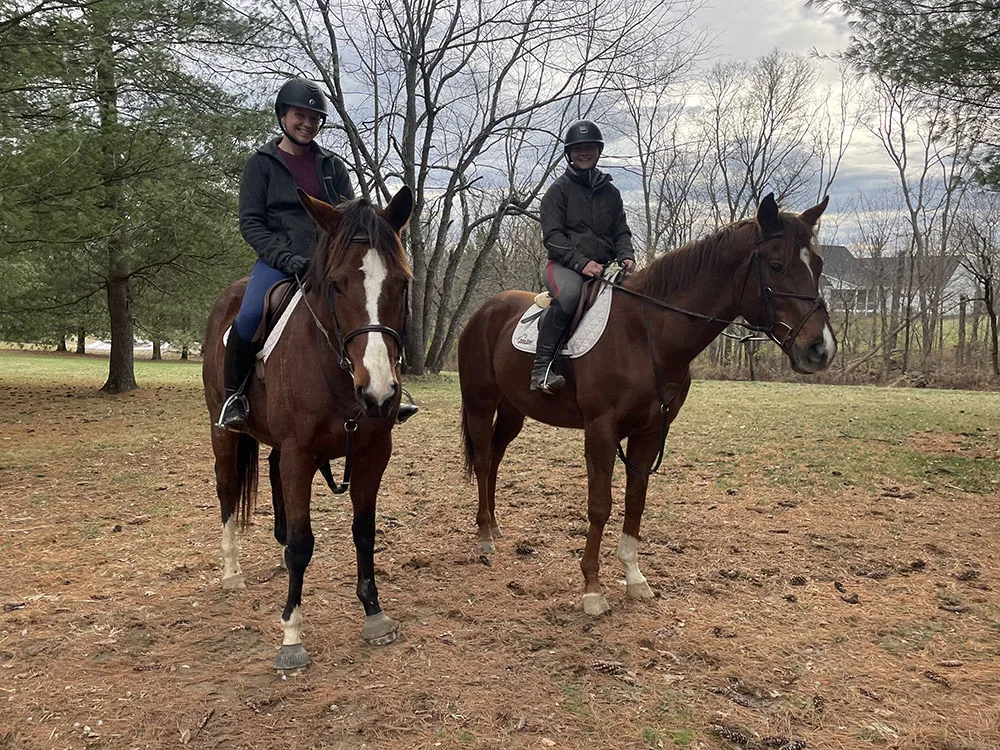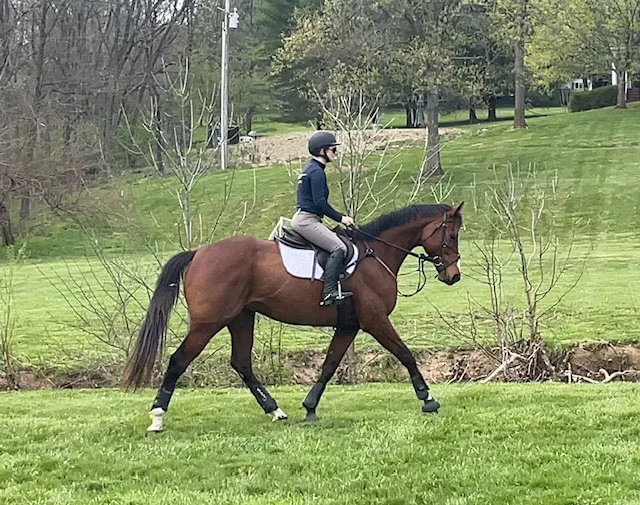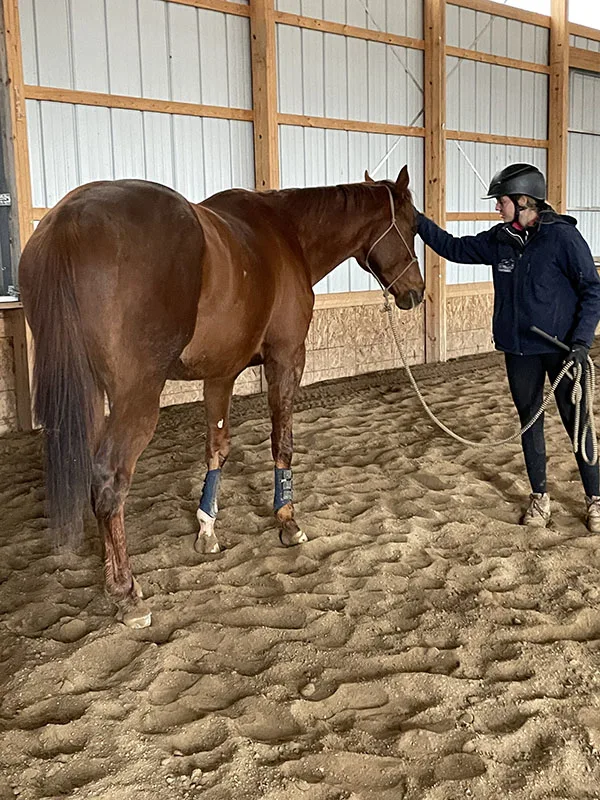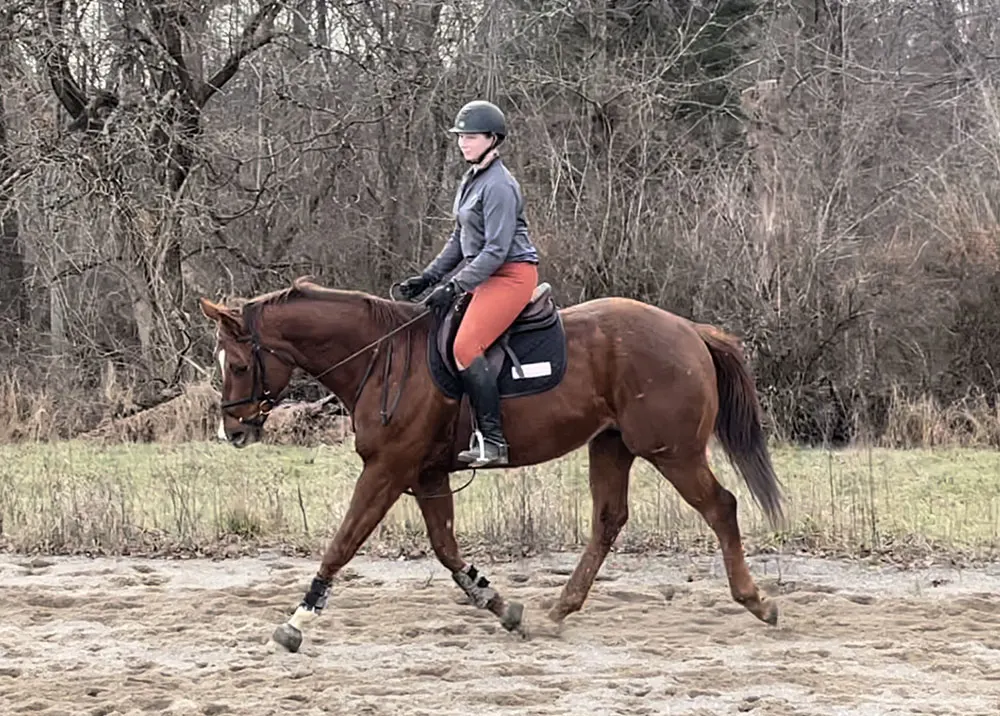I am so incredibly excited to be blogging about my 2023 Retired Racehorse Project Thoroughbred Makeover prospects and their journeys! I have always loved writing, and I am thrilled to have been asked to blog about the retraining of my Makeover horses by The Chronicle of the Horse! COTH is THE magazine (real life, hard copy magazine) that I remember always seeing as a kid, in tack shops, around the barn and our house! Some may assume that since I became known for my success in the Thoroughbred racing industry, it could have been The BloodHorse. But I actually was born into the show horse world and grew up in Somerset Hills Pony Club (New Jersey) at the same time as Olympians Doug Payne and McLain Ward, though they are a bit older. Yes, I am a fangirl, and, yes, I just shamelessly name dropped. Not that I have a record to confirm, but it is likely that I rode my first horse trials at the Paynes’ farm in Califon, New Jersey, probably around age 5 and definitely on my 12-hand Welsh pony, Sweet Sensation, who would later become my champion race pony, among other things.
I was lucky enough to be born into a family of horse people: My mother, Cindy Napravnik, is a Pony Club instructor; my father, Charles Napravnik, a farrier; my brother, Colt, enabled my tomboy lifestyle; and my older sister, Jazz, did all of the horsey things first. Thanks to them, there was a well-beaten path for me to follow from leadline, to short stirrup, to eventing, mounted games, Pony Club rallies, Pony (jumper) Finals, and then pony racing, amateur racing and finally to Pimlico Racetrack.
In 2004 I ventured off in my own direction to become a flat jockey. I had a relatively short but incredible career that introduced me to wonderful people, places and experiences I never could have imagined.
A large part of my decision to retire after the 2014 Breeder’s Cup came from the desire to have kids, but there were many factors that went into it. My desire to actually work with horses was one of them.
At the level to which I had climbed in racing, the horses were worth so much money that they were bubble wrapped—rightfully so—and any time I spent with one of them was while it was tethered to a groom, a pony horse or a gate hand. All I did was get on and get off. The only time I got to spend one-on-one with a horse was from the gate to the wire. Although those 1-2 minutes were all I had ever wanted at one time in my life, that suddenly became not nearly enough. I still love racing; I obviously love Thoroughbreds, and now I am most privileged to have a second career which allows me to absolutely have it all.

Upon my retirement, I became the assistant trainer to my husband, Joe Sharp, who had recently started training his own string of horses after a decade of working as an assistant. I worked tirelessly (not really—I was super tired) through both of my pregnancies. I LOVED IT! Starting out with mostly claiming horses, Joe thrived on improving them when they arrived in his barn. I was in awe, sitting back and soaking it all up like a sponge. I also LOOOOVED when the 2-year-olds came in. They were blank slates, and it was like Christmas in April, unwrapping those four-legged packages.
Nonetheless, my assistant trainer career was short-lived; I just could not keep my cup full working 14-20 hours a day between the kids and the racetrack. It surprised me that I burned out so quickly, but then again, I didn’t quite know what to expect while having two kids under 2.
Not only was I working crazy hours during that time, I also had loaded my plate with a few other projects, like buying and developing a farm, taking on racetrack layups and sitting on the boards of multiple aftercare organizations, one of which was the Retried Racehorse Project.
Igniting A Makeover Spark
RRP founder Steuart Pittman had called me, when I was pregnant with my first son, to ask if I’d become a board member. As he told me more about the RRP, he casually mentioned that I could train a horse for the makeover.
A spark was ignited. There was definitely a part of me that struggled in my transition out of the career that I had worked toward my whole life. The thought of training a horse for the Makeover gave me a new sense of purpose. How ironic, right?
From that phone call I was connected with Kentucky-based five-star eventer Dorothy Crowell, and in conjunction with the Secretariat Center we trained Dare Me, donated by the wonderful My Meadowview Farm, for the 2015 Makeover. I was pregnant at the time, so Dorothy trained the horse and then handed the reins over in August, after my son was born in June, and I continued taking lessons with her leading up to the Makeover in October. Our early lessons consisted mostly of “thumbs up” and “hands together” as I tried to remember, from when I was 12, how to “do dressage.” I was a trainwreck of a rider after spending the previous 15 years galloping in the position of a grasshopper, and it was very humbling.
ADVERTISEMENT
I was incredibly fortunate, and am eternally grateful, to have benefitted from Dorothy’s invaluable instruction. She somehow saw my potential under the years of bad riding habits and helped me from ride No. 1 on several horses over the next four years … until she crushed my dreams and moved to Florida! (Not really—I’m still dreaming the dreams, I just feel bad for myself and cry to her about it once in a while.)
Dorothy coached me on a regularly inconsistent basis (between her winters in Florida and my summers in Saratoga, New York) from 2015 through the 2019 Makeover, when I won the eventing division with one of my husband’s former trainees, Sanimo. I still make Dorothy coach me virtually because she gets me, and, as far as coach/student relationships go, we’re soulmates. She pumps me up with, “You should ride for our country,” and I squash that with, “I’ve had my glory, please help me in my journey to ride horses both to the left AND the right!” Plus, she is the kindest of all bubble-bursters, and that is so, so important in all aspects of life!
Meet “Hank”
Both of my prospects this year have come out of my husband’s barn. Tour Taker is a Calumet Farm homebred (Oxbo—Take D’ Tour, Tour D’Or), a drop-dead gorgeous show-stopper, standing at least 16.3 hands with a beautiful red-bay coat, a blaze and stockings. He retired as a coming 3-year-old colt who hadn’t shown a whole lot of speed on the track and then also sustained a fractured tibia. He arrived at my farm in February 2022 and had all the time in the world to rehab from that injury, which should be non-limiting in a second career.

“Hank’s” journey started with three months of stall rest, then handwalking, then the round pen, then small-paddock turnout. When it was time for him to transition to full turnout, he was going to have to fit into my herd, which meant castration was next. It is always beneficial to keep them moving after they’re castrated, so to help his healing, he actually went out on trot sets with the racehorses who were legging up after rehab before returning to the track. We also practiced groundwork during that time. Once his castration healed, Hank went back on the shelf and hung around with all the lifers in the “back forty” (my 8-acre field) for a while.
Between the holidays and me just having too many horses to train, Hank didn’t start hacking until the last week in December. Every horse I restart will hack for a week or two or until walking around on the buckle becomes what they associate with their new life under saddle. As we approached the one-year anniversary of his arrival on the farm, it was finally time for me to swing a leg over him for his much-anticipated “first ride”—except I selflessly gave that privilege away to my student and my right hand, Shelby Starks!
Hank was always such a puppy dog that I figured he would be a great horse for Shelby to learn the process on from step one, so we would swap back and forth with that first couple weeks of flat rides. Hank was a great horse for Shelby as she learned the first steps of teaching him to stop and go from her seat and to move away from her leg at the walk. Once we started moving into transitions and doing more work at the trot, though, Hank needed a bit of troubleshooting. He is a bit cockier under saddle than I originally thought he would be. He’s not a bad actor, but he can have that kind of colt-like demeanor, with his eyes rolled back in his head, unable to think about anything but himself.
Troubleshooting with Hank involves tackling his ideas such as, “I can move off your leg right, but I can’t move off your leg left.” Or, “I can move of your leg left, but I can’t move off your leg left when we are by the door of the indoor, or the corner by my turnout, or anyplace that makes me think about heading back to my barn, where life is just much less complicated and you feed me so much alfalfa.”
All are the natural thoughts of a horse—to do what they were born to do, survive while grazing in a field—but he thinks them with more conviction than some. So, what did we do?
Short, Sweet, Positive, Rewarding
We went back to groundwork. We just kept his world small, literally working on the end of a rope, and asked simple questions that he knew how to answer. That way, he understood and could learn to trust that we will always be consistent in what we ask, and he will always be rewarded. I did this a few days just from the ground, and then I added a saddle and a rope halter so that I could start with groundwork and then, once he was working with me as a partner, I could get on and ask the same questions from the saddle. It wasn’t long before I could just leave the groundwork out and start back under saddle. In cases like this, it is the timing of corrections and releases that are so important and contribute to the horse’s progress.

I find that the most common resistance from a fresh OTTB is presented as “I can’t.” They quite literally believe that they cannot do a thing—bend right, cross a stream, walk over a bridge, etc.—until you show them that they absolutely can. Keeping a positive and rewarding relationship between myself and my horses has always gotten me the furthest, though I’ll be the first to admit that finding that out was a (very humbling) process. Hank’s resistance was more of “I don’t want to,” but in both cases the process is essentially the same: Keep things short, sweet, positive and rewarding.
ADVERTISEMENT
My favorite way to teach a horse to jump is over natural-looking cross-country fences. (Side note: When horses live in our back forty for a couple of months, they cross a large tree line to half the pasture and often have to jump over fallen logs or cross the stream that runs through my entire property. I call it “living in the wild,” and it is so good for them.) Hank learned to jump on his first trip off property when we took a slew of babies to school cross-country. His snappy knees made me feel like I was being thoroughly rewarded for the patience I’ve practiced in letting this horse sit and heal over the past year. Hank is a GOOD jumper and was so quick to find his own distances but also very receptive to me helping him find it when he needed.
I don’t typically expect to do a lot of cantering fences on the first jump day, but Hank understood the assignment from the very start. Not for nothing, he was perfectly well behaved out in a big field, being asked to do something he had never done but thought was very fun. Because we’ve been focused on solidifying a partnership working on the flat in the arena, Hank has only jumped one other time, which coincidentally was at the same venue as the first. It’s not a bad idea to duplicate a positive outing, but he’s certainly ready for the next step and will soon start jumping regularly.
Meet “Sam”
My second prospect is Sacred Samurai. “Sam,” aka Clifford the Big Red Dog. He is another well-bred (First Samurai—Surfer’s Paradise, Congrats), ginormous, 17-hand puppy dog who also came to me as a colt with an injury. The first time Sam was in my barn, he was a coming 3-year-old and had undergone surgery for a cracked shin. This is a common injury for a 2-year-old racehorse and one that does not limit their careers. Sam was an amazingly well-behaved colt back then, and he had us drooling over him every day when we started legging him up to go back to the track. He came back a winner and was a very exciting 3-year-old for Joe to have in the barn, but unfortunately he bowed a tendon. His owners, Big E Stables, decided to retire him instead of bringing him back from a second injury. Lucky ME! Sam did himself every favor throughout his rehab, being the absolute perfectly quiet puppy that he is. He too had “brain surgery” while he was healing, and through a similar progression (although he did more walking than jogging after his castration than Hank) he made it out to “the big field” with more than enough time to rehab his injury before starting his training in January.

Sam was started in the same fashion as Hank, with groundwork and hacking and then moving toward flat work. Sam though, is the class pet—just as easy as they come and always looking to do his best job.
He has already been to his first schooling dressage show, where he acted like a perfect angel and also brought home two blue ribbons from his Intro B and Intro C tests! It doesn’t hurt that Sam is probably the best mover that has ever come through my program, and I am so utterly thrilled to have this horse in my barn for as long as I may be privileged to have him. His uphill and balanced gaits will also contribute tremendously in preserving his soundness.
Because his training has involved less troubleshooting, Sam has done a bit more jumping than Hank. His first three jumps were in the arena, not for any particular reason other than we weren’t going on field trips that day. So to introduce show jumps, we started with poles on the ground and let him figure out where to put his feet around them. His jumping style was a bit “divey” at first, so we have used placing poles and gymnastics to help him figure out how to push off with his hind legs as opposed to hurling his front end over the jump. The jumps stay quite low for now, of course, because we are consciously and carefully rehabbing his injury.
Each of these horses currently hacks once a week. We are privileged to have hundreds of acres of land to hack on, which gives us the opportunity to regularly cross creeks, walk through ditches and hop up banks and ride over all sorts of terrain that helps strengthen their toplines. They both flat two to three times weekly, and during their flat days we will also incorporate pole work to help them gain strength and awareness of where they are putting their feet.
Now that Hank has matured in his flat work a bit, they will likely both start jumping once or twice a week around their two days off. The next month of training will be a busy one, and there will likely be lots to share about these two big hunks in my next blog, so stay tuned!
Rosie Napravnik is a former jockey who holds multiple riding titles throughout the country, is a two-time winner of the Kentucky Oaks, the only female jockey to win multiple Breeder’s Cup races and the only female to ride in all three Triple Crown races. Retired from racing since 2014, Rosie lives in Simpsonville, Kentucky, with her husband, Joe Sharp, and their three children. Rosie runs a private Thoroughbred rehab and retraining operation, Off-Track Sporthorses, from the family’s Four Ponds Farm. Rosie has also created a boutique lesson program for kids, advocating for kids learning more than what an arena has to offer.














